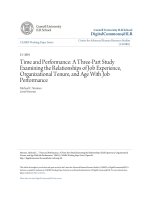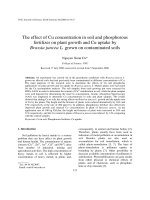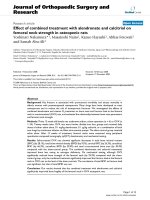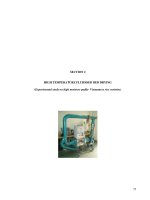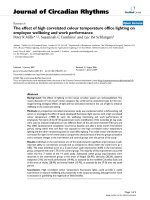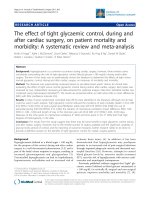The effect of work-life conflics, working environment and compensation on employee performance im Vietnamese domestic banks
Bạn đang xem bản rút gọn của tài liệu. Xem và tải ngay bản đầy đủ của tài liệu tại đây (862.48 KB, 86 trang )
UNIVERSITY OF ECONOMICS HO CHI MINH CITY
International School of Business
------------------------------
Nguyen Thi Anh Ngoc
THE EFFECT OF WORK-LIFE
CONFLICTS, WORKING
ENVIRONMENT AND
COMPENSATION ON EMPLOYEE
PERFORMANCE IN VIETNAMESE
DOMESTIC BANKS
MASTER OF BUSINESS (Honours)
Ho Chi Minh City – Year 2014
UNIVERSITY OF ECONOMICS HO CHI MINH CITY
International School of Business
------------------------------
Nguyen Thi Anh Ngoc
THE EFFECT OF WORK-LIFE
CONFLICTS, WORKING
ENVIRONMENT AND
COMPENSATION ON EMPLOYEE
PERFORMANCE IN VIETNAMESE
DOMESTIC BANKS
ID: 21110038
MASTER OF BUSINESS (Honours)
SUPERVISOR: Dr. TRAN HA MINH QUAN
Ho Chi Minh City – Year 2014
ACKNOWLEDGEMENT
This thesis could not have been accomplished without the help, advice, support, guidance and
encouragement of many people.
I wish to explain my sincere gratitude to my advisor, Dr. Tran Ha Minh Quan, for his kind
guidance, intensive support, valuable suggestions, instructions and encouragement during the
time of doing my research.
I also would like to thank my dear colleagues, friends and classmates for their invaluable
advice, help, support during the time I was doing this thesis.
Last but not least, I would like to express my special thanks to my man and my family for
their great support, assistance and encouragement for my study and thesis fulfillment.
Nguyen Thi Anh Ngoc
November 2014
EMPLOYEE PERFROMANCE IN VIETNAMESE DOMESTIC BANKS
ii
ABSTRACT
Vietnam, like the rest of Asia, has entered a period of slower growth. Besides the
manufacturing and agricultural sectors, other industry sectors are being adversely affected by
the slower growth and the Banking sector is no exception. Series of banks restructure itself
with human resource as an important part: layoffs the ineffectives and higher employees’
performance for the remains. It is clear that employees take a key figure for banks’
performance. Go along with the issue, managers should control what contribute for higher
employees’ performance to enhance the competitive advantages of banks.
As a result, all three determinants which are work-life conflicts, working environment and
compensation impact on employee performance in Vietnamese domestics banks whereas
compensation has the highest impact on performance of banking staff in significantly high
level. Imbalance in work-life negatively impact on performance bank in turn. Working
environment also has positively impact on bank staff productivity but with the lowest
significance.
The result of the study can contribute for human resource management for enhancing
productivity and performance of banking staff in the future.
Key words: Employee performance (EP), work-life conflicts, working environment (WE),
compensation (COM), Vietnamese domestic banks (VDBs).
EMPLOYEE PERFROMANCE IN VIETNAMESE DOMESTIC BANKS
iii
LIST OF FIGURES
Figure 1: Conceptual research model .................................................................................... 18
Figure 2: Research process ....................................................................................................... 20
LIST OF TABLES
Table 1: Income of bank staffs by year .................................................................................... 03
Table 2: Income and average profit of bankers in 2013 ........................................................... 04
Table 3: Distribution system of banks in 2013 ......................................................................... 19
Table 4: Demographic information .......................................................................................... 21
Table 5: Measurement scale...................................................................................................... 22
Table 6: Reliability statistics of compensation variable .......................................................... 29
Table 7: Reliability statistics of COM variable with 5 factors ................................................ 30
Table 8: Reliability of Work-life conflicts variable ................................................................. 31
Table 9: Reliability statistics of WLC variable with 5 factors.................................................. 32
Table 10: Reliability of working environment variable ........................................................... 32
Table 11: Reliability of WE variable with 4 factors ................................................................ 33
Table 12: Reliability statistics of Employee performance variable ......................................... 33
Table 13: KMO and Barlette’s test .......................................................................................... 36
Table 14: Total Variance Explained ........................................................................................ 37
Table 15: Rotated Component Matrix ..................................................................................... 38
Table 16: KMO and Barlette’s test & Total Variance Explained of second EFA .................... 38
Table 17: KMO and Barlette’s test & Total Variance Explained ............................................. 38
Table 11: Coefficient ................................................................................................................ 41
Table 19: ANOVA ................................................................................................................... 41
Table 20: Model Summary ....................................................................................................... 42
EMPLOYEE PERFROMANCE IN VIETNAMESE DOMESTIC BANKS
LIST OF ABBREVIATIONS
EP
Employee Performance
COM
Compensation
WE
Working Environment
WLC
Work-Life Conflicts
VSBs
Vietnamese Domestics Banks
HRM
Human Resource Management
SOCBs
State-Owned Commercial Banks
JSCBs
Joint-Stock Commercial Banks
S&D
Sales and Distributors
iv
EMPLOYEE PERFROMANCE IN VIETNAMESE DOMESTIC BANKS
v
CONTENTS
ACKNOWLEDGEMENT .......................................................................................................... i
ABSTRACT ............................................................................................................................... ii
LIST OF FIGURES ..................................................................................................................iii
LIST OF TABLES ....................................................................................................................iii
LIST OF ABBREVIATIONS ................................................................................................... iv
CHAPTER 1 .............................................................................................................................. 1
INTRODUCTION ..................................................................................................................... 1
1.1 Research background .......................................................................................................... 1
1.2 Research objectives and questions ...................................................................................... 4
1.3 Scope of the research .......................................................................................................... 5
1.4 Conclusion .......................................................................................................................... 5
CHAPTER 2 .............................................................................................................................. 7
LITERATURE REVIEW, HYPOTHESIS AND RESEARCH MODEL ................................. 7
2.1 Introduction......................................................................................................................... 7
2.2 Theoretical review .............................................................................................................. 7
2.2.1
Employee performance ............................................................................................ 7
2.2.2
Work-life Conflicts (WLC) or Work-life Imbalance .............................................. 8
2.2.3
Working Environment ........................................................................................... 10
2.2.4
Compensation ........................................................................................................ 11
2.3 Hypothesis development ................................................................................................... 13
2.3.1
Work-life conflicts and employees’ performance ................................................. 13
2.3.2
Working Environment and employee performance............................................... 14
2.3.3
Compensation and employees’ performance ......................................................... 14
2.4 Research model ................................................................................................................. 15
2.5 Conclusion ........................................................................................................................ 16
EMPLOYEE PERFROMANCE IN VIETNAMESE DOMESTIC BANKS
vi
Chapter 3 .................................................................................................................................. 17
METHODOLOGY .................................................................................................................. 17
3.1 Introduction....................................................................................................................... 17
3.2 Research design ................................................................................................................ 17
3.3 Research sample size and techniques, sample discription ................................................ 18
3.3.1
Sample size ............................................................................................................ 19
3.3.2
Sample technique................................................................................................... 20
3.3.3
Sample description ................................................................................................ 21
3.4 Measurement ..................................................................................................................... 22
3.5 Data analysis methods ...................................................................................................... 24
3.5.1
Testing reliability of scales by using Cronbach’s Alpha and Coefficient ............. 24
3.5.2
Exploratory Factor Analysis .................................................................................. 25
3.5.3
Multiple regression analyses ................................................................................. 26
3.6 Conclusion ........................................................................................................................ 27
Chapter 4 .................................................................................................................................. 28
RESULTS ................................................................................................................................ 28
4.1 Brief description of subjects ............................................................................................. 28
4.3 Patterns of data for each research question ....................................................................... 29
4.3.1
Preliminary evaluation scale with Cronbach’s Alpha ........................................... 29
4.3.2
Exploratory Factor Analysis (EFA)....................................................................... 35
4.3.3
Regression analysis................................................................................................ 40
4.4 Conclusion ........................................................................................................................ 43
Chapter 5 .................................................................................................................................. 44
CONCLUSIONS AND IMPLICATIONS............................................................................... 44
5.1 Discussions ....................................................................................................................... 43
EMPLOYEE PERFROMANCE IN VIETNAMESE DOMESTIC BANKS
5.2
vii
Managerial implications .............................................................................................. 44
5.3 Limitations and recommend for further research ............................................................. 47
5.4 Conclusions....................................................................................................................... 47
REFERENCES ........................................................................................................................ 49
APPENDIX A: SURVEY QUESTIONAIRE ......................................................................... 54
ENGLISH SCALE ................................................................................................................... 61
APPENDIX B – DATA ANALYSIS RESULTS .................................................................... 63
Factor Analysis .................................................................................................................... 63
Regression ............................................................................................................................ 74
EMPLOYEE PERFROMANCE IN VIETNAMESE DOMESTIC BANKS
1
CHAPTER 1
INTRODUCTION
This chapter presents the introduction to the study. It contains the research background,
research problems, research objective, the significant of research and research structure
1.1
Research background
The objective of business owners is profitability. Organization’s success depends on
employees’ performance. Poor performance is detrimental to company’s success. Even
employee performance can make or break an organization’s success.
Banking industry has sufficiently undergone rapid changes and with the entry of
foreign players and strong private players the face of industry was redefined completely.
Indeed, according statistics from Vietnamwork, demand for labor force of banking used to be
always at the top job hunter and top most desirable jobs in the period of 2006-2007 due to its
rapidly development both vertically and horizontally, however, in time of economics deficit,
this became against in the later period, begun from 2011. In wake of these changes, the
changes in fundamentals and structure of banking industry majorly also affected the role of
internal customers - the employees of the industry. Besides several other changes took place
in the industry which led to huge churning of employees in the industry thus the need for
caring for the satisfaction of employees also became important.
There are several antecedents of employee satisfaction found in various studies
conducted in different areas of different industries and sectors. The cost of employee turnover
to firms to firms has been estimated to be up to 150% of the employees remuneration package
(Schlesinger &Heskett, 1991)…This number, once again, raises up a warning of improving
job satisfaction for effective use of resource.
There has had number of studies about determinants affect on employee performance
worldwide such as Impact of Compensation, Performance Evaluation and Promotion
EMPLOYEE PERFROMANCE IN VIETNAMESE DOMESTIC BANKS
2
Practices on Government Employees Performance VS Private Employees Performance (Bilal
Jamil, 2011); Contributory Factors in Employee Satisfaction: An Empirical Investigation of
Banking Industry (Pareek&Vandana, 2013); Determinants of Employees Performance in
Corporate Sector: Case of an Emerging Market (Mubbsher M. Khan & Maryam Jabbar,
2013); Work-Life Balance Practices in the Banking Sector: Insights from Nigeria
(ChimaMordi& Stella IbiyinkaOjo, 2011); The Effect of Earning, Working Environment, and
Promotion Opportunities on Employees’ Performance: A Comparison between the State
Sector and Other Sectors in Vietnam (Dang Xuan Chuong, 2012), etc. In Vietnam, in time of
slower of growth, highly-affected-by-rumor banking system, high turnover in banking labor
force, low performance, the significance to consider the most influencing factors from some
previous research about earning, working environment, and promotion opportunities affect
employee performance becomes crucial action to enhance banks’ success.
Issues for bank employees The banking industry also suffers from high employee
turnover rate. One of the seven remarkable Vietnam banking issues in 2013 is the changes in
both senior personnel (CEO) and higher requirements for branch directors and cut in labor
force along with salary to cut operating cost from 10 to 20 percent in banks. The cut in labor
force issued in the form of giving high target or directly considering and cutting. When the
performance is not good enough to meet the target, the employees themselves, or the results
from their performances lead them to be fire.
In the financial report from banks, every indicators related to bankers’ income
decrease in 2013 in comparison with those of the year 2012. See in table 1 below.
EMPLOYEE PERFROMANCE IN VIETNAMESE DOMESTIC BANKS
3
Table 1: Income of bank staff by year
2013
2012
Stock code
No. of
employees
Total
income (bil.
VND)
Average
income (mil.
VND)
No. of
employees
Total
income
(bil. VND)
Average
income
(mil. VND)
CTG
MBB
VCB
BID
19,886
5,759
13,864
18,389
4,638
1,210
2,873
3,604
19.67
17.52
17.27
16.33
19,840
5,593
13,637
18,215
4,622
1,172
2,718
2,172
20.22
17.46
16.61
14.91
Techcombank
7,290
1,386
16.00
7,168
1,388
15.00
STN
EIB
ACB
NamABank
DongABank
NVB
11,662
5,689
9,131
1,083
5,301
1,579
2,128
950
1,411
133
633
174
15.21
13.91
12.92
10.23
9.94
9.17
11,334
5,614
10,275
1,071
5,206
1,569
1,922
1,171
1,737
122
515
207
14.13
17.38
14.08
9.45
8.24
11.00
TOTAL/
AVERAGE
99,633
19,140
14.38
99,522
17,746
14.41
(Source: Collect from Consolidated financial statement 2013 of banks)
Employees in healthy banks were more satisfied in their jobs and experienced lower
levels of anxiety than employees in distressed banks (Samuel, Osinowo&Chipunza, 2009).
This is the matter of healthy workplace environment. The profit in banks is lower and much
of rumors of banks’ operation created doubt in customers and staff themselves.
The current economic condition seems to have exacerbated these problems.
Considering the issues of low wages (compensation), high turnover and job insecurity
among bank employees (workplace environment), it is not surprising to find that create worklife conflicts and low performance. From the financial report in 2012, 2013, there are only
banking officers of Vietinbank and Military bank create much more than they receive, the
rest still show low performance or not stable performance.
EMPLOYEE PERFROMANCE IN VIETNAMESE DOMESTIC BANKS
4
Table 2: Income and Average profit of bankers in 2013
Bank name
Monthly Average Income
MB
Vietinbank
Sacombank
Techcombank
VPBank
Vietcombank
BIDV
SHB
Eximbank
ACB
Kienlong Bank
Ocean Bank
DongA Bank
Average Profit Created Per Person
17.4
17.1
16.9
15
15
14.7
13.2
13.1
12.5
12.5
9.85
9.38
8.99
46.2
39.6
23.4
11.7
10.1
32.3
24.6
16.7
22.5
17.8
13.3
7.6
10.7
(Source: Complied from Financial statement of banks third-quarter-end of 2013)
Not only decreasing in banker income, it is not really accurate to calculate average
profit an employee brings about count on bank profit and number of employees of that bank
only. In fact, profit from many banks comes from many others source rather than the profit
from Sales and Distributors channel (S&D) such as Eximbank, Tien Phong banks are good at
arbitrage of international currency exchange, VP bank gets much profit in recent years by
investing in financial subsidiary companies, etc. This means that, in some banks, there may
find that there are increasing in income, but in fact, they are managing out more and pay with
the same Salary fund, not because of the remaining are working more effectively.
It appears that something more fundamental is contributing to the overall problem.
Reviewing the root causes of low job performance from the three key factors can provide
some understanding of the problems with bank employees along with possible solutions.
1.2
Research objectives and questions
The objective of the present study is to measure how identified factors influence
employees’ performance in domestic banks. Consequently, the research questions of the
thesis are raised as following questions:
EMPLOYEE PERFROMANCE IN VIETNAMESE DOMESTIC BANKS
-
5
How do work-life conflicts, working environment, compensation affect on
employees’ performance in Vietnamese domestic banks?
1.3
Is there any relationship between 3 determinants affecting in employee performance?
Scope of the research
The research is conducted in Ho Chi Minh City with 260 respondents who work in
both state-owned banks and private owned with various positions, banks.
Questionnaire is about to 3-6 items for each determinant about Work-Life Conflicts,
Working Environment, Compensation and Promotion Opportunities affect employees’
performance.
The timeframe of research intentionally lasts in three-month period from May to the
end of July in 2014. There might be changes in survey depending on how much the bank will
allow them and their willingness. The confidentiality of information about their answer can
be one of the biggest limitations of the study as the respondents themselves are often scared
of showing their workplace.
1.4
Conclusion
This paper is organized into five sections.
It begins with the introduction section. This chapter one examines the issues of
employee’s performance in Vietnamese domestic banks under the effect of work-life
confilicts, working environment and compensation. Moreover, this chapter determines the
research problem as well as objective.
The next section, chapter two describes related literature review concerned
Vietnamese domestics banking employee’s performance in regarding of effect of three main
factors and research hypotheses.
In chapter 3, this third section is research design, research methodology used to
empirically test the research model. It also reports the process of doing the research.
EMPLOYEE PERFROMANCE IN VIETNAMESE DOMESTIC BANKS
6
Chapter 4 - The forth section presents the results of data analysis. Based on the
results, the author of the paper aill go deep analysis of each factor that impacts on employee’s
performance.
The final section – chapter 5, discusses summarizes the study’s core findings and
implications, its contributions and its limitations.
EMPLOYEE PERFROMANCE IN VIETNAMESE DOMESTIC BANKS
7
CHAPTER2
LITERATUREREVIEW,HYPOTHESISANDRESEARCHMODEL
2.1
Introduction
In this chapter, theoretical background and review on previous studies are presented.
This chapter includes three sections. The first section is theoretical review relating to critical
factors and employee performance. The second describes the hypothesis development for this
research. The last section presents Research model.
2.2
Theoretical review
2.2.1
Employee performance
Measuring performance is of great importance to an in centive plan because it
communicates the importance of established organizational goals. “What gets measured and
rewarded gets attention” (Bohlander et al, 2001).
Employee performance is measured by various factors like absenteeism, turnover,
productivity and employee satisfaction (Gibson, 1990). The performance is defined as the
attained outcome of actions with the skills of employees who perform in some situation
(Prasetya& Kato, 2011). According to Suhartini (1995) employee performance is a mutual
result of efforts, abilities and perception of tasks. Good performance is the step towards
achievement of organizational aims. Hence more effort is required to improve the employee
performance.
Employee performance means employee productivity and efficiency as a result of
employee growth. Employee performance will impinge on the organization’s performance.
However the excellent working of the workforce at all levels of organization has a major
influence on organization’s performance.
Each employee’s productivity has an impact on organization’s goals therefore it is
essential that each individual employee should be managed. Performance of the employees
EMPLOYEE PERFROMANCE IN VIETNAMESE DOMESTIC BANKS
8
plays a key role for organizations. Employees are the asset for the organization.
Organizations have learned the importance of the people in the organization in that without
them the organization’s objectives could not be accomplished.
2.2.2
Work-life Conflicts (WLC) or Work-life Imbalance
There is no single universally acceptable definition of work-life balance; a lot will
depend on the frame of reference scholars are using. The meaning of the term varies with the
age, interest, value, personal circumstance and personality of each individual (Torrington,
Hall and Taylor, 2009).
Work-life conflict is defined as a form of inter-role conflict in which work and family
demands are mutually incompatible so that meeting demands in one domain makes it difficult
to meet demands in the other (Edwards & Rothbard, 2000; Greenhaus & Beutell 1985). This
definition implies a multi-directional relationship where work can affect family and vice
versa (Frone, 2002). When work and family are in conflict, obtaining rewards in one domain
requires foregoing rewards in the other (Edwards and Rothbard, 2000). Work-life conflict can
be considered to have two major components: the practical aspects associated with time
crunches and scheduling conflicts (i.e. an employee cannot be in two different places at the
same time), and the perceptual aspect of feeling overwhelmed, overloaded or stressed by the
pressures of multiple roles. From the previous studies, the study of Chris Higgins, Linda
Duxbury and Sean Lyons in 2008 conceptualized work-life conflict broadly to include:
Role overload: This form of work-life conflict occurs when the total demands on time
and energy associated with the prescribed activities of multiple roles are too great to
perform the roles adequately or comfortably.
Work-to-family interference: This type of role conflict occurs when work demands
and responsibilities make it more difficult to fulfill family-role responsibilities (e.g.
long hours in paid work prevent attendance at a child's sporting event, preoccupation
EMPLOYEE PERFROMANCE IN VIETNAMESE DOMESTIC BANKS
9
with the work role prevents an active enjoyment of family life, work stresses spill
over into the home environment and increase conflict with the family).
Family-to-work interference: This type of role conflict occurs when family demands
and responsibilities make it more difficult to fulfill work-role responsibilities (e.g. a
child's illness prevents attendance at work, conflict at home makes concentration at
work difficult).
Caregiver strain: Caregiver strain is a multi-dimensional construct defined in terms of
"burdens" in the caregivers' day-to-day lives, which can be attributed to the need to
provide care or assistance to someone else who needs it (Robinson,
Work-life conflict is a form of inter-related conflict in expectation between both work
and family life roles (Higgins, Duxbury and Lyons, 2007). It is obvious that every
organization wants to enhance the capability/productivity of output (goods/services),
consequently high level performance from each employee is very important for an
organization. On the contrary, studies suggest that work-life conflicts create stress on the
employee and cause low performance for organization. It is important for an organization to
gain an optimal level of performance from an employee but work-life conflicts put limitations
on such achievements.
When employees fail to fulfill their family requirements from a job, work-life
conflicts begin to exist (Netemeyer, Brashear-Alejandro, & Boles,
2004);
however,
two
factors especially help to accelerate work-life conflicts. First, strain-based and second, timebased conflicts. Time-based conflict occurs when an individual dedicates most of the time to
work and fails to encounter the family obligations. Strain-based conflicts occurs when
immense workload effects one mentally or puts pressure corporeally (Quick
et
al.,
2004). The relationship between turnover intention and work-life conflict is positive. When
the employee intends to leave the organization it is evident that he/she is not satisfied and
EMPLOYEE PERFROMANCE IN VIETNAMESE DOMESTIC BANKS
does
10
not want to remain with the company. There are distinctive methods of actions and
policies to reduce these conflicts (Higgins, Duxbury, & Lyons, 2007)
From the foregoing, the definition can assume social, economic and legislative forms.
Definition of Karatepe and Uladag (2007) is based on social issues associated with
individuals ‘irrespective of marital, race or gender’ to attain an improved suit between paid
work and personal life. The economic perspective was described by Russell, O’Connell and
McGinnity (2009); it is described as companies encouraging individuals to achieve balance as
a result of benefits they would gain such as high retention of staff, which is referred to as the
‘business case approach’. The main aim of the business case approach is that it results in a
reduction in absenteeism of employees and also portrays the organization as a good
employer.
2.2.3
Working Environment
There are many factors in employees’ workplace environment that greatly impact
their level of enthusiasm and performance. The workplace’s environment affects employee
confidence, output and commitment - both positively and negatively. Therefore it is not just a
coincidence that new incentive programs which focus on lifestyle changes, work/life balance,
health and fitness issues were previously not considered as significant payback tactics, but are
now common practices amongst well-reputed corporations, and primary considerations of
potential employees.
A widely accepted assumption is that better workplace environment motivates
employees and produces better results. Office environment can be described in terms of
physical and behavioral components. Based on Brill et al. (1985), they had stated that there
are a few factors of physical work environment that need to be improved. The factors are
such as lightings, the floor configuration, office layout and also the furniture layout. In
Leader Value website, behavioral components is described in eight key factors including (1)
EMPLOYEE PERFROMANCE IN VIETNAMESE DOMESTIC BANKS
11
goal-setting, (2) performance feedback, (3) role congruity, (4) defined processes, (5)
workplace incentives, (6) supervisor, (7) mentoring/coaching and (8) resource availability.
The class of the employees’ workplace environment highly affects their level of
motivation and the following performance. How well they engage with the organization,
especially with their workplace environment, influences to a great extent their error rate, level
of innovativeness, relationship with other employees, rate of absenteeism and, finally how
long they continue to work.
2.2.4
Compensation
The literal meaning of compensation is to counter-balance. In the case of human
resource management, compensation is referred to as money and other benefits received by
an employee for providing services to his employer (Mohanta, (n.d)). Money and benefits
received may be in different forms-money form and various benefits, which may be
associated with employee’s service to the employer like provident fund, gratuity, and
insurance scheme, and any other payment which the employees receive or benefits.
Compensation is systematic approach to providing monetary value to employees in
exchange for work performed. Compensation may achieve several purposes assisting in
recruitment, job performance, and job satisfaction.
Mondy and Noe (1993) has devided compensation in two types’ financial
compensation and non-financial compensation. Financial compensation is futher devided into
direct and in-direct financial compensation. Direct compensation includes bounce, good
salary packages, profits and commission. Indirect financial compensation are those benefits
that are not covered by direct financial compensation. Non-financial compensation consists of
responsisbilities, opportunities, recognition promotion, vacations, work-place environement,
sound policies, insurance, medical, retirement etc. All these compensations effect the
performances of employees in different manners.
EMPLOYEE PERFROMANCE IN VIETNAMESE DOMESTIC BANKS
12
Compensation management, also known as wage and salary administration,
remuneration management, or reward management, is concerned with designing and
implementing total compensation package. The traditional concept of wage and salary
administration emphasized only on determination of wage and salary structures in
organizational settings.
However, over the passage of time, many more forms of compensation, entered the
business field which necessitated to take wage and salary administration in competitive way
with a suitable change in its nomenclature.
Cascio has defined compensation as follows: "Compensation includes direct cash
payments, indirect payments in the form of employee benefits and incentives to motivate
employees to strive for higher levels of productivity”
Compensation processes are based on compensation philosophies and approaches
which are developed and supervised to give and sustain suitable types and levels of financial
compensation (Bob, 2011). Armstrong (2005) argued that compensation management is a
vital part of human resource management (HRM) and it moves toward organization’s
performance. It leads to design and implement compensation plans that are geared to the
enhancement of organization and employee’s productivity.
Importance of HR practices in under-developed countries has been recognized by
Anakwe (2002). There are many variables which are included in HR practices but in this
research work three HR practices are included which are compensation, promotion and
performance evaluation. These three factors have strong relationship each others. The main
reason of selecting is based on fact represented by (Shahzad, Bashir, and Ramay, 2008) that
in under-developed countries physiological requirements (compensation, promotion and
performance evaluation) have significant influence on employees’ performance.
EMPLOYEE PERFROMANCE IN VIETNAMESE DOMESTIC BANKS
13
Compensation administration is one of the most important areas of human resource
management because sound compensation policies, programs and their effective execution
are essential to procure, maintain and develop the human resource of the organization to get
effective result from them. It involves the selection, designing, development and direction of
programs designed to implement compensation or incentive policy through financial rewards.
2.3
Hypothesis development
2.3.1
Work-life conflicts and employees’ performance
According to Cohen & Single (2001) there is lot of pressure on the management of
the organization to prove to be a friendlier one to the employees. Grover and Crooker (1995);
and Scandura and Lankau (1997) have found that the employees’ sense of responsibility to
organization become more progressive when flexible time scheduling is being adopted by the
organization. Brandt, Krawczyk&Kalinowski (2008) examined that the work-life balance
relationship exhibits a negative correlation. According to Ali and Baloch (1999) conflict
negatively affects the personal life of employees which results in their low performance.
Ahmad (2008) also remarks that work and family conflict is inversely linked to employees’
performance. It is also examined that work and family conflict decreases employee
satisfaction, increases employees stress and decreases performance.
There have been many definitions of work-life conflicts, however, in general, it
relates to same main ideas. In this research, the author decided to measure factor work-life
conflicts based on the scale of Netemeyer, McMurrian&Boles’s, 1996 on four main
constructs: work-to-family interferences, family-to-work interferences, time-based and strainbased with full ten items from the principal scale.
Hypotheses H1: There is a negative impact of work-life conflicts on employee
performance.
EMPLOYEE PERFROMANCE IN VIETNAMESE DOMESTIC BANKS
2.3.2
14
Working Environment and employee performance
Work environment can be made pleasant by controlling the noise, pollution,
temperature, lighting and improving facilities to reduce physical risks. According to Yesufu
(1984) in order to enhance employees’ output, a suitable work-environment is vital. If the
environment of organization is excessively noisy, polluted, warm and ill ventilated, the
employee performance will be diminished.
The conditions at working environment may be favorable or unfavorable to the
employees. In favorable conditions employees tend to share their pleasant experiences and
express their true attitudes. In this environment the negligent employees tend to transform
into those who feel a sense of accountability. In unfavorable conditions employees are likely
to share their unpleasant experiences and in this environment the employees with a sense of
accountability or rationalism tend to change into unaccountable and irrational employees. The
most recognized theory is that when the working environment is suitable for employees they
show better performance in the organization. When employees contribute better input then
their output boosts accordingly and employee productivity also enhances.
Hypotheses H2: There is a positive impact of working environment on employee
performance.
2.3.3
Compensation and employees’ performance
Compensation is the major element that affects the employee performance. If
employees are satisfied that organization is offering a good compensation then their
motivation is at a higher level and as a result their work performance is also better off.
Robbins (2001) said that when employees feel happy about their compensation they are more
motivated towards their work and the performance of the company also boosts.
Cameron and Pierce (1996) said that many organizations use pay, promotion and
benefits to give more confidence to better performing employees. Management of the
EMPLOYEE PERFROMANCE IN VIETNAMESE DOMESTIC BANKS
15
organization often anticipates this depending on the strengths and responsibilities of such
employees and these expectations are different from organization to organization.
Teseema&Soeters (2006); and Shahzad et al. (2008) have described that there is a significant
relationship among employee performance and compensation practices.
Providing respecful compensation to the employees ò an organisation has soothing
effect of both organisation and employee performance (Jamil and Safaraz, 2011). To improve
the performance, organizations are trying to improve the performance of human capital.
Hypotheses H3: There is a positive impact of compensations on employee
performance.
2.4
Research model
1.
Work-life
1.1.1 conflicts
Working
environment
H1
H2
Employee Performance
H3
Compensation
Figure 1: Conceptual research model
Hypotheses H1: There is a negative impact of work-life conflicts on employee
performance.
Hypotheses H2: There is a positive impact of working environment on employee
performance.
Hypotheses H3: There is a positive impact of compensations on employee
performance.
EMPLOYEE PERFROMANCE IN VIETNAMESE DOMESTIC BANKS
2.5
16
Conclusion
Various researches have studied of these three factors’ impact on emplyees’
performance. This chapter explores these constructs and their independent variable –
employees’ performance in more details to identify shared patterns in the relationship
between them. The primary focus of this chapter was to present definitions of the
variables, then, specific evidence of relationship between three selected dependent
variables and the independent one were pointed out, also a collection from previous
research. Understanding these natures could be helpful in later comparison of
bankers’ performance in hypothesis and actual results.

